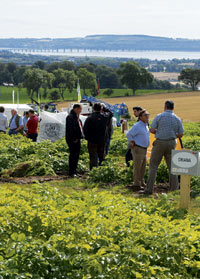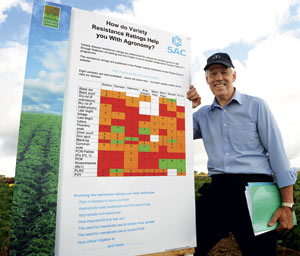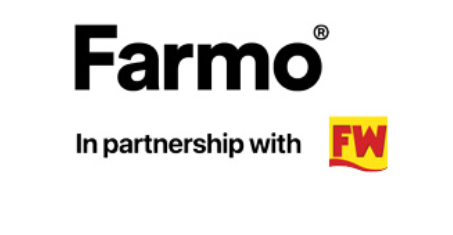Potato growers put stewardship first

Stewardship of existing and new pesticide products in the face of new legislation was the key message at this year’s Potatoes in Practice event, at SCRI’s Balruddery Farm, Dumfries.
Concerns over the severity of the EU pesticide directive and the Water Framework Directive dominated proceedings and growers were urged to take action now to protect remaining products and practices.
Speaking at the event, Potato Council’s Rob Clayton asked growers to act in a “sound, justified and diligent” manner.
“The most important message is stewardship – we are going to be assessed on how well we respond to stewardship issues and we are going to have to take it very, very seriously.”
Production could decrease by 15% in the next 10 years, if products were lost, he said. “So it is essential to act now and protect them.”
Alternative control measures should also be considered, he added. “We need to look more seriously at longer rotations, better use of tolerant varieties and integrating with biocontrols, such as trap cropping and mustard crops.”
While the EU pesticide directive had been a serious concern, the WFD was likely to be next challenge, he said.
“The consequences of the EU pesticide directive are relatively well known, but the WFD is becoming more and more significant in terms of the way we manage pesticides.
“As with many EU directives the biggest proportion of the activity takes place in the last third so we really need to watch out. We have already seen the river quality reports, we’ve seen what has happened with abstraction licences and we are expecting a lot more.”
The industry, therefore, needed to prevent further deterioration of water quality and seek improvements, he added.
“We are doing a lot of things right already, such as the proportion of the industry in an assurance scheme, the proportion that has been through the voluntary initiative and the fact that some residue issues have already gone away.
“But we need to get together and say this: The Potato Council will be doing so on grower’s behalf, but you need to get together as groups and make your own representations, too.”
Understand variety before planting
 Growers should consider disease resistance more carefully when choosing varieties, said SAC’s Stuart Wale.
Growers should consider disease resistance more carefully when choosing varieties, said SAC’s Stuart Wale.
“Using disease resistance ratings will highlight any weaknesses and enable the grower to plan agronomy strategies ahead.”
They also helped growers to put the right variety in the right field, he said. “If the soil has a history of a particular disease it is no good planting a variety with a low level of resistance to it.”
Variety disease resistance ratings weren’t being used enough despite being extremely valuable, especially given current agronomic pressures, he said.
“I’m not saying a variety shouldn’t be planted if it has some weaknesses, but growers should be aware of these and plan agronomy to suit.”
Resistance ratings can be found on the Potato Council website: www.potato.org.uk/varieties.
Indian mustard could protect against pests and diseases
Planting a biofumigant crop such as Indian mustard before potatoes could give pest and disease control programmes a significant boost, said Jim Rennie, technical director for CSC Crop Protection.
“USA Indian mustard trials under laboratory conditions showed 100% control of rhizoctonia, pink rot and pithium, 90% control of sclerotinia and 80% control of dry rot.” The different between this and green mustard was substantial, he said.
Higher levels of glucosinolates, the substance that gives mustard its heat, was the secret to the crop’s activity, he said. “When the crop is incorporated into the soil glucosinolates give off isothiocyanate gas, which acts as a natural soil sterilant.”
In the field, crops had shown a significant reduction in black dot, improvements in skin finish and some activity against Potato Cyst Nematode. He was also investigating using mixtures of bio-crops to boost PCN activity.
“This additional crop gives off exudates from roots that encourage PCN to hatch out and in early field trials PCN levels were reduced by 40-50%.”
That activity was particularly interesting with the PCN directive coming in next year, he said. “Everybody will have to have a schedule of how they will reduce PCN levels in their soil and these crops can play a major part in achieving this.”
The crop can fit into standard rotations, and is inexpensive to grow, he says. “Planting date is similar to oilseed rape, which gives time to achieve sufficient biomass. Seed costs between £25 and £30/ha depending on seed rate.”

